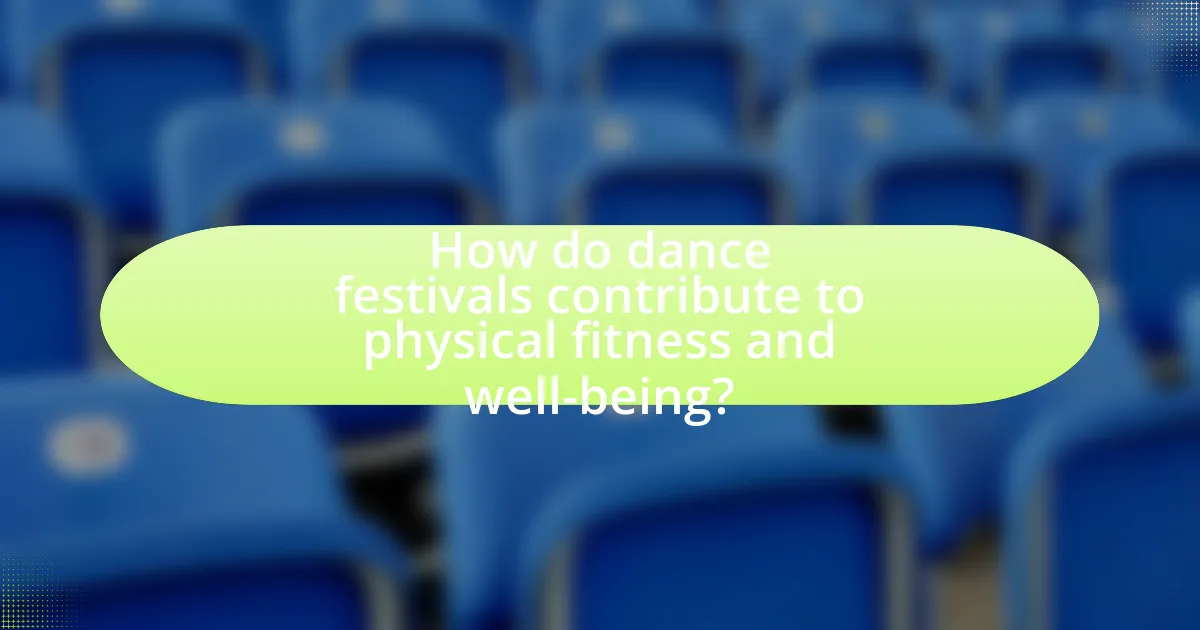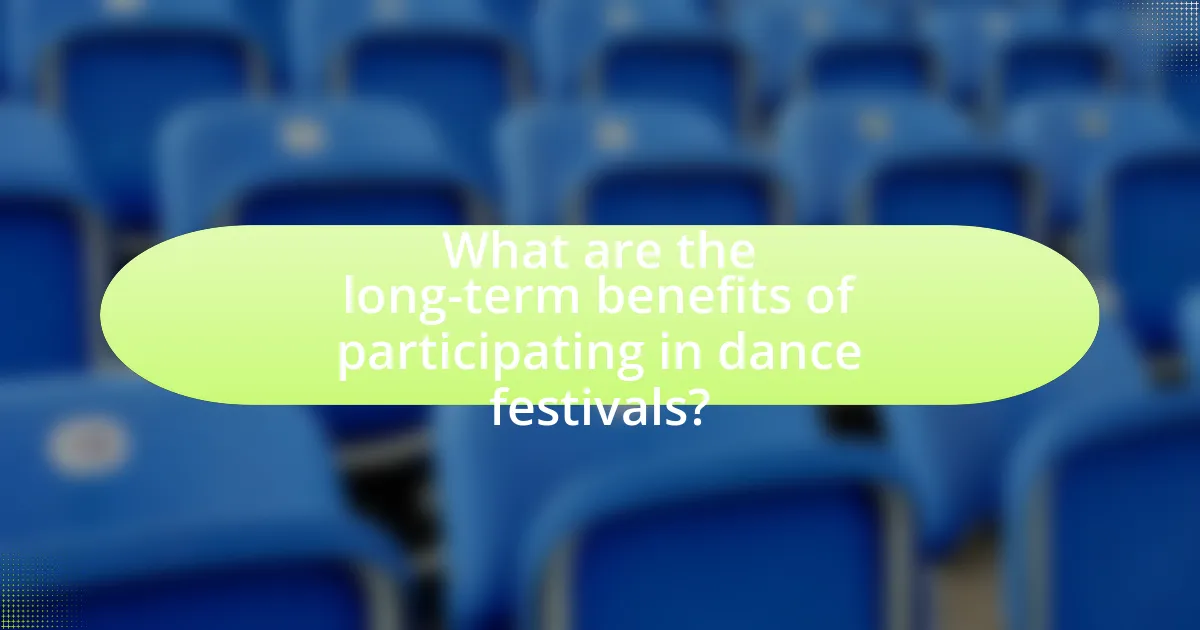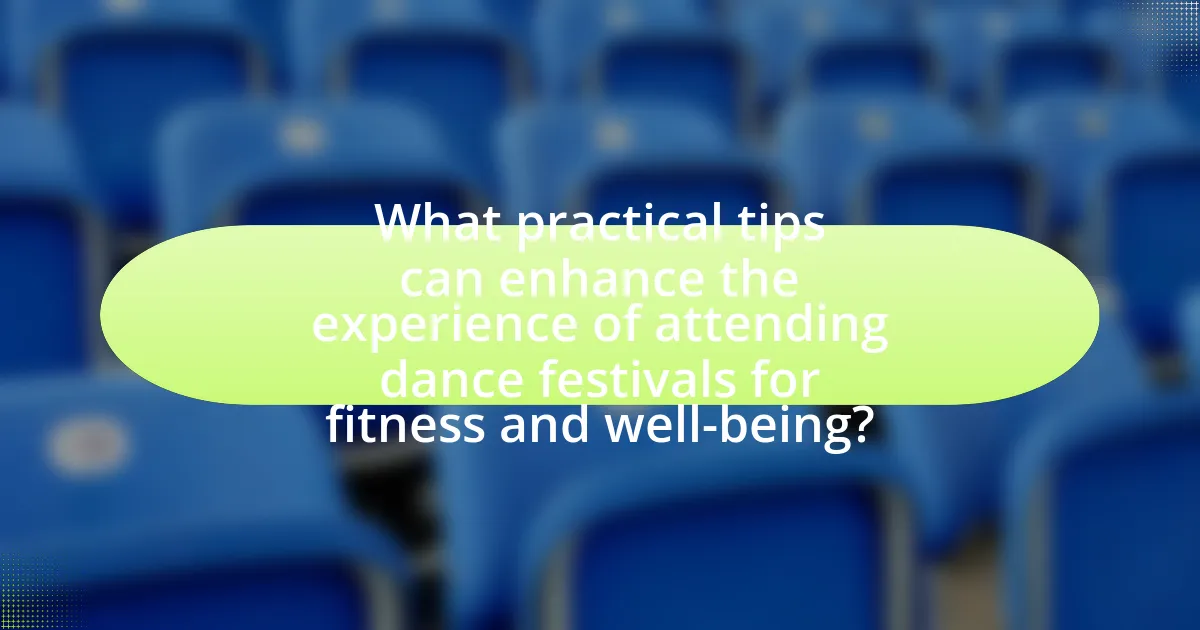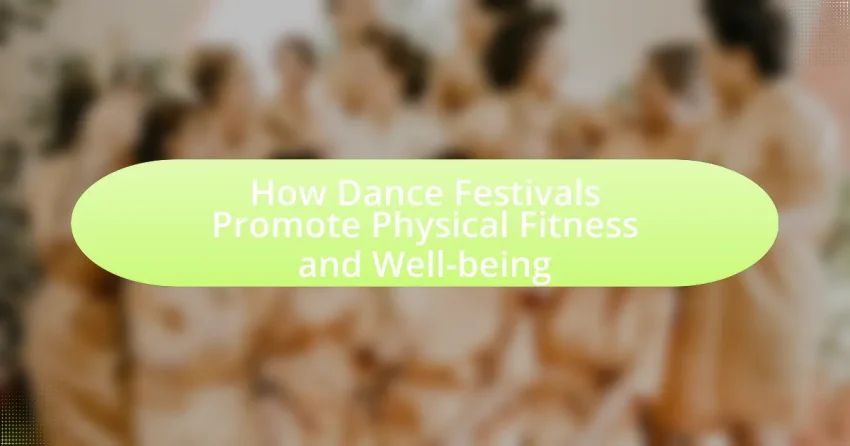Dance festivals serve as a dynamic platform for enhancing physical fitness and overall well-being through various dance styles that promote movement, coordination, and endurance. These events not only improve cardiovascular health, flexibility, and muscle strength but also foster social interaction, which is linked to better mental health outcomes. The article explores the types of physical activities involved in dance festivals, the impact of different dance styles on fitness, and the mental health benefits derived from social dancing. Additionally, it highlights how dance festivals encourage community engagement, promote healthier lifestyle choices, and provide practical tips for maximizing the experience, ultimately demonstrating the long-term benefits of regular participation in these events.

How do dance festivals contribute to physical fitness and well-being?
Dance festivals contribute to physical fitness and well-being by providing an engaging platform for participants to engage in physical activity through dance. These events typically involve various dance styles that require movement, coordination, and endurance, which can enhance cardiovascular health, flexibility, and muscle strength. Research indicates that regular participation in dance can lead to improved physical fitness levels; for example, a study published in the Journal of Physical Activity and Health found that dance participants exhibited higher levels of aerobic fitness compared to non-dancers. Additionally, dance festivals foster social interaction and community engagement, which are linked to improved mental health and emotional well-being, further supporting the overall health benefits associated with these events.
What types of physical activities are involved in dance festivals?
Dance festivals involve various physical activities, including dancing, stretching, and aerobic exercises. These activities promote cardiovascular fitness, flexibility, and muscle strength. For instance, participants engage in different dance styles such as salsa, hip-hop, and ballet, which require significant physical exertion and coordination. Research indicates that dancing can burn approximately 300-400 calories per hour, contributing to overall physical fitness and well-being. Additionally, group dance activities foster social interaction, enhancing mental health alongside physical benefits.
How do different dance styles impact physical fitness?
Different dance styles significantly impact physical fitness by enhancing cardiovascular health, strength, flexibility, and coordination. For instance, styles like ballet improve flexibility and core strength due to their emphasis on posture and controlled movements, while hip-hop and salsa provide vigorous cardiovascular workouts that increase heart rate and endurance. Research published in the Journal of Physical Activity and Health indicates that participants in dance classes experience improved aerobic capacity and muscle strength, demonstrating the effectiveness of dance as a form of exercise. Additionally, a study by the American Council on Exercise found that dance can burn between 200 to 400 calories per hour, depending on the intensity and style, further supporting its role in physical fitness.
What role does social dancing play in promoting fitness?
Social dancing plays a significant role in promoting fitness by providing a fun and engaging way to increase physical activity levels. Engaging in social dance can elevate heart rates, improve cardiovascular health, and enhance muscle strength and flexibility. Studies indicate that participants in social dancing can burn between 200 to 400 calories per hour, depending on the intensity of the dance style. Additionally, social dancing fosters social interaction, which can lead to improved mental well-being, further motivating individuals to maintain an active lifestyle.
Why are dance festivals effective for improving mental health?
Dance festivals are effective for improving mental health because they foster social connections, promote physical activity, and enhance emotional expression. Engaging in dance at these festivals allows individuals to connect with others, reducing feelings of isolation and loneliness, which are significant contributors to mental health issues. Research indicates that social interaction can lead to increased feelings of happiness and decreased anxiety levels. Additionally, the physical activity involved in dancing releases endorphins, which are known to improve mood and reduce stress. A study published in the Journal of Positive Psychology found that participants who engaged in dance reported higher levels of life satisfaction and lower levels of depression. Thus, the combination of social engagement, physical movement, and emotional expression at dance festivals creates a supportive environment that significantly benefits mental health.
How does participation in dance festivals reduce stress and anxiety?
Participation in dance festivals reduces stress and anxiety by providing a platform for physical expression, social interaction, and emotional release. Engaging in dance activates the body’s endorphin production, which are natural mood lifters, and promotes a sense of well-being. Additionally, the communal atmosphere of dance festivals fosters social connections, reducing feelings of isolation and enhancing emotional support. Research indicates that physical activity, such as dancing, can lower cortisol levels, a hormone associated with stress, thereby contributing to overall mental health improvement.
What are the social benefits of attending dance festivals for mental well-being?
Attending dance festivals provides significant social benefits that enhance mental well-being, primarily through community engagement and social interaction. These festivals foster a sense of belonging and connection among participants, which can reduce feelings of loneliness and isolation. Research indicates that social connections are crucial for mental health; for instance, a study published in the journal “Psychological Science” found that individuals with strong social ties experience lower levels of anxiety and depression. Additionally, the shared experience of dancing and celebrating together promotes positive emotions and collective joy, further contributing to improved mental health outcomes.
How do dance festivals encourage community engagement and support?
Dance festivals encourage community engagement and support by providing a platform for local artists and participants to connect, collaborate, and celebrate cultural diversity. These events foster social interaction among attendees, creating a sense of belonging and community pride. For instance, studies have shown that community-based dance festivals can increase local participation by up to 30%, as they often include workshops, performances, and activities that invite community members to engage actively. Additionally, dance festivals often partner with local businesses and organizations, enhancing economic support and promoting local culture, which further strengthens community ties.
What community resources are often available at dance festivals?
Dance festivals often provide community resources such as workshops, health screenings, and local vendor booths. Workshops offer participants opportunities to learn new dance styles and techniques, enhancing their physical fitness and well-being. Health screenings, often conducted by local health organizations, provide attendees with access to information about their physical health, promoting awareness and preventive care. Local vendor booths typically feature healthy food options and wellness products, supporting a holistic approach to health during the festival. These resources collectively contribute to the overall goal of promoting physical fitness and well-being within the community.
How do dance festivals foster connections among participants?
Dance festivals foster connections among participants by creating a shared space for interaction, collaboration, and cultural exchange. These events often include workshops, performances, and social dancing, which encourage attendees to engage with one another, share experiences, and build relationships. Research indicates that social interactions in such environments can enhance feelings of belonging and community, as participants often bond over a mutual passion for dance. Additionally, the diverse backgrounds of attendees contribute to a rich tapestry of cultural exchange, further strengthening connections among individuals.

What are the long-term benefits of participating in dance festivals?
Participating in dance festivals offers long-term benefits such as improved physical fitness, enhanced mental well-being, and increased social connections. Regular engagement in dance activities promotes cardiovascular health, flexibility, and strength, contributing to overall physical fitness. Studies indicate that dance can reduce symptoms of anxiety and depression, fostering a positive mental state over time. Additionally, dance festivals create opportunities for social interaction, which can lead to lasting friendships and a sense of community, further enhancing emotional well-being. These benefits are supported by research showing that physical activity, particularly in social settings, is linked to improved mental health outcomes and a stronger support network.
How can regular participation in dance festivals lead to sustained fitness?
Regular participation in dance festivals can lead to sustained fitness by providing consistent physical activity that engages various muscle groups and enhances cardiovascular health. Dance festivals typically involve multiple hours of dancing, which can burn significant calories; for instance, a person can burn approximately 400-600 calories per hour depending on the intensity of the dance style. This regular engagement not only improves strength, flexibility, and endurance but also fosters a sense of community and motivation among participants, encouraging them to maintain an active lifestyle. Studies have shown that social support in physical activities, such as those found in dance festivals, can increase adherence to fitness routines, thereby promoting long-term health benefits.
What are the cardiovascular benefits of consistent dance participation?
Consistent dance participation significantly improves cardiovascular health by enhancing heart efficiency and increasing aerobic capacity. Engaging in dance regularly elevates heart rate, which strengthens the heart muscle and improves blood circulation. Studies indicate that individuals who dance frequently experience lower resting heart rates and improved cholesterol levels, contributing to reduced risks of heart disease. For instance, a study published in the Journal of Physical Activity and Health found that dance can lead to a 30% increase in cardiovascular fitness among participants. This evidence underscores the effectiveness of dance as a form of aerobic exercise that promotes overall cardiovascular well-being.
How does dance improve flexibility and strength over time?
Dance improves flexibility and strength over time by engaging various muscle groups through dynamic movements and stretches. The consistent practice of dance routines enhances the range of motion in joints and increases muscle elasticity, which contributes to greater flexibility. Additionally, the resistance provided by body weight during dance movements builds muscle strength, particularly in the core, legs, and arms. Research indicates that dancers often exhibit higher levels of flexibility and strength compared to non-dancers, as evidenced by a study published in the Journal of Dance Medicine & Science, which found that regular dance training significantly improves both flexibility and muscular strength in participants.
What impact do dance festivals have on lifestyle choices?
Dance festivals significantly influence lifestyle choices by promoting physical activity, social interaction, and mental well-being. Participants often adopt healthier habits, such as regular exercise and improved nutrition, as they engage in dance and related activities. Research indicates that attending dance festivals can lead to increased physical fitness levels, as individuals are motivated to maintain their health to fully enjoy the experience. Additionally, the communal atmosphere fosters social connections, which can enhance emotional health and encourage a more active lifestyle. Studies have shown that individuals who participate in dance-related events report higher levels of satisfaction and well-being, reinforcing the positive impact of dance festivals on overall lifestyle choices.
How do dance festivals promote healthier eating habits among participants?
Dance festivals promote healthier eating habits among participants by providing access to nutritious food options and fostering a community that values wellness. These events often feature food vendors that prioritize healthy, locally sourced ingredients, encouraging attendees to choose better dietary options. Additionally, workshops and informational sessions at dance festivals frequently emphasize the importance of nutrition in relation to physical activity, reinforcing the connection between healthy eating and overall well-being. Studies have shown that environments promoting healthy choices can significantly influence dietary behaviors, making dance festivals effective platforms for encouraging healthier eating habits among their participants.
What lifestyle changes are commonly observed in regular festival attendees?
Regular festival attendees often experience increased physical activity levels, improved social connections, and enhanced mental well-being. These lifestyle changes stem from the immersive nature of dance festivals, which typically involve hours of dancing, walking, and engaging in various physical activities. Research indicates that participants in such events report higher levels of physical fitness due to the sustained movement and energy expenditure associated with dancing. Additionally, the communal atmosphere fosters social interactions, leading to stronger relationships and a sense of belonging, which are crucial for mental health. Studies have shown that social engagement can reduce feelings of loneliness and depression, further contributing to overall well-being.
How do dance festivals influence personal motivation and goal setting?
Dance festivals significantly enhance personal motivation and goal setting by creating an immersive environment that fosters community engagement and artistic expression. Participants often experience heightened enthusiasm and inspiration from the vibrant atmosphere, which encourages them to set and pursue personal fitness and performance goals. Research indicates that social interactions at these events can lead to increased commitment to dance practices, as individuals feel a sense of belonging and accountability within the community. For example, a study published in the Journal of Physical Activity and Health found that social support during group activities, such as dance festivals, positively correlates with sustained motivation and goal achievement in physical fitness.
What role does goal setting play in enhancing fitness through dance?
Goal setting plays a crucial role in enhancing fitness through dance by providing clear objectives that motivate individuals to improve their skills and physical health. When dancers set specific, measurable, achievable, relevant, and time-bound (SMART) goals, they create a structured pathway for progress, which can lead to increased commitment and consistency in their practice. Research indicates that goal setting can enhance performance and motivation, as evidenced by a study published in the Journal of Sport & Exercise Psychology, which found that athletes who set goals experienced greater improvements in their performance compared to those who did not. This structured approach not only fosters a sense of achievement but also encourages dancers to engage in regular physical activity, ultimately contributing to better overall fitness and well-being.
How can dance festivals inspire participants to pursue fitness outside of events?
Dance festivals inspire participants to pursue fitness outside of events by creating a vibrant community atmosphere that emphasizes movement and physical expression. This environment encourages individuals to engage in regular dance practice and fitness activities, as they often feel motivated by the energy and enthusiasm of fellow attendees. Research indicates that social support and community involvement significantly enhance motivation for physical activity, leading to increased participation in fitness routines post-event. For example, a study published in the Journal of Physical Activity and Health found that individuals who participate in group activities, such as dance festivals, are more likely to maintain an active lifestyle due to the social connections formed during these events.

What practical tips can enhance the experience of attending dance festivals for fitness and well-being?
To enhance the experience of attending dance festivals for fitness and well-being, participants should prioritize hydration, wear comfortable clothing, and engage in warm-up exercises. Hydration is crucial as it helps maintain energy levels and prevents fatigue; studies show that even mild dehydration can impair physical performance. Wearing comfortable clothing allows for greater freedom of movement, which is essential for enjoying dance activities fully. Engaging in warm-up exercises prepares the body for physical exertion, reducing the risk of injury and enhancing overall performance. These practical tips collectively contribute to a more enjoyable and health-focused experience at dance festivals.
How can participants prepare physically for a dance festival?
Participants can prepare physically for a dance festival by engaging in a structured fitness regimen that includes cardiovascular training, strength building, flexibility exercises, and dance practice. Cardiovascular training, such as running or cycling, enhances stamina, which is crucial for enduring long hours of dancing. Strength training, focusing on core and leg muscles, improves balance and power, essential for executing dance moves effectively. Flexibility exercises, like stretching or yoga, increase range of motion and reduce the risk of injury. Regular dance practice allows participants to refine their skills and build muscle memory, ensuring they are well-prepared for the festival’s demands.
What warm-up exercises are recommended before attending a dance festival?
Dynamic stretching exercises are recommended before attending a dance festival. These exercises, such as leg swings, arm circles, and torso twists, help increase blood flow to the muscles and improve flexibility, which is essential for the physical demands of dancing. Research indicates that dynamic stretching can enhance performance and reduce the risk of injury by preparing the body for movement (Behm et al., 2011, Journal of Sports Sciences). Engaging in these warm-up activities ensures that dancers are physically ready to participate in the festival’s activities.
How can participants stay hydrated and energized during the event?
Participants can stay hydrated and energized during the event by regularly consuming water and electrolyte-rich beverages. Maintaining hydration is crucial, as studies indicate that even mild dehydration can impair physical performance and cognitive function. Additionally, consuming snacks that are high in carbohydrates and proteins, such as fruits, nuts, and energy bars, can help sustain energy levels throughout the event. Research shows that proper hydration and nutrition can enhance endurance and overall enjoyment of physical activities, making it essential for participants to prioritize these aspects during dance festivals.
What strategies can enhance social connections at dance festivals?
To enhance social connections at dance festivals, organizers can implement interactive workshops and group activities that encourage participation and collaboration among attendees. These strategies foster a sense of community and belonging, as participants engage in shared experiences that promote bonding. Research indicates that social interactions in group settings can lead to increased feelings of happiness and well-being, which are essential components of the overall festival experience. Additionally, creating designated social spaces, such as lounges or communal areas, allows attendees to meet and connect outside of dance activities, further strengthening social ties.
How can attendees engage with others to maximize their experience?
Attendees can engage with others to maximize their experience by participating in group dance classes and workshops. These activities foster interaction and collaboration, allowing individuals to learn from each other and build connections. Research indicates that social engagement in physical activities, such as dance, enhances enjoyment and motivation, leading to improved physical fitness and well-being. For instance, a study published in the Journal of Physical Activity and Health found that group participation in dance significantly increases social bonding and overall satisfaction among participants.
What are some ways to find dance partners or groups at festivals?
To find dance partners or groups at festivals, attendees can utilize social media platforms and festival-specific apps to connect with others interested in dancing. Many festivals have dedicated online communities where participants can post about their dance styles and seek partners. Additionally, joining workshops or group classes offered at the festival can facilitate meeting like-minded dancers. Research indicates that social interactions at such events enhance the overall experience, promoting both physical fitness and well-being through increased engagement in dance activities.
